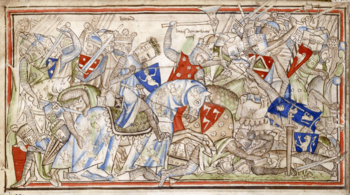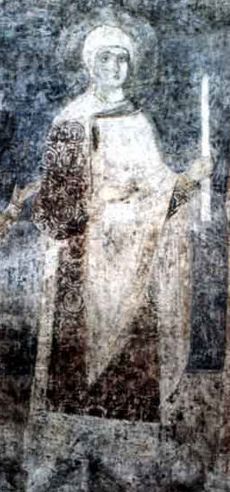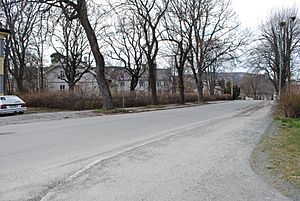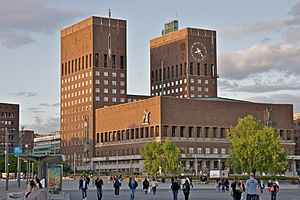Harald Hardrada facts for kids
Quick facts for kids Harald Hardrada |
|||||
|---|---|---|---|---|---|
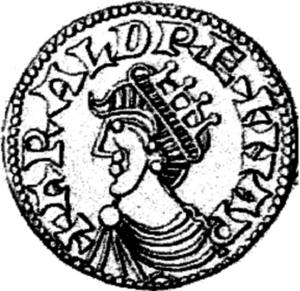
Coin of Harald as the sole Norwegian king, "ARALD[us] REX NAR[vegiae]". Imitation of a type of Edward the Confessor.
|
|||||
| King of Norway | |||||
| Reign | 1046 – 25 September 1066 | ||||
| Predecessor | Magnus I | ||||
| Successor | Magnus II | ||||
| Co-ruler | Magnus I (until 1047) | ||||
| Born | c. 1015 Ringerike, Norway |
||||
| Died | 25 September 1066 (aged 50–51) Stamford Bridge, Yorkshire, England |
||||
| Burial | Trondheim; Mary Church until 12th century, Helgeseter Priory until 17th century (demolished) | ||||
| Spouse | Elisiv of Kiev Tora Torbergsdatter |
||||
| Issue | Ingegerd, Queen of Denmark and Sweden Maria Haraldsdatter Magnus II, King of Norway Olaf III, King of Norway |
||||
|
|||||
| House | Hardrada | ||||
| Father | Sigurd Syr | ||||
| Mother | Åsta Gudbrandsdatter | ||||
| Religion | Catholicism | ||||
Harald Sigurdsson (born around 1015 – died 25 September 1066) was a famous King of Norway from 1046 to 1066. He is also known as Harald III of Norway and by his nickname Hardrada. This name means "stern counsel" or "hard ruler". Before becoming king, Harald spent about fifteen years as a mercenary (a soldier who fights for money) and military leader. He served in Kievan Rus' and as the chief of the Varangian Guard in the Byzantine Empire. He also tried to claim the thrones of Denmark and England, but was not successful.
Contents
Early Life and First Battle
Harald was born in Ringerike, Norway, around 1015. His mother was Åsta Gudbrandsdatter, and his father was Sigurd Syr, a local king. Harald was the youngest half-brother of Olaf Haraldsson, who later became known as Saint Olaf.
When Harald was about fifteen years old, in 1030, he fought alongside his half-brother Olaf in the Battle of Stiklestad. Olaf wanted to get back the Norwegian throne, which he had lost to the Danish king Cnut the Great. In the battle, Olaf and Harald were defeated. Olaf was killed, and Harald was badly wounded. Harald had to leave Norway and go into exile.
Adventures in the East
Life in Kievan Rus'
After the battle, Harald escaped to a farm in Eastern Norway to heal. Then, he traveled north to Sweden. About a year later, in 1031, Harald arrived in Kievan Rus', a large state in Eastern Europe. The sagas (old Norse stories) called it Garðaríki.
Harald and his 500 men were welcomed by Grand Prince Yaroslav the Wise. Yaroslav needed military leaders and saw Harald's potential. He made Harald a captain in his army. Harald's brother Olaf had also been in exile with Yaroslav before. Harald fought in Yaroslav's campaigns against the Poles in 1031 and possibly against other groups like the Chudes and Pechenegs.
Serving the Byzantine Empire
Around 1033 or 1034, Harald and his men moved south to Constantinople. This was the capital of the Byzantine Empire. There, they joined the Varangian Guard, who were the emperor's special bodyguards. Harald quickly became a commander of the Guard.
Harald fought in many parts of the empire. He battled Arab pirates in the Mediterranean Sea and in Asia Minor. By 1035, he was leading the Varangians. He took part in campaigns that reached the Tigris River and Euphrates River in Mesopotamia. According to his poet, Þjóðólfr Arnórsson, Harald helped capture eighty Arab strongholds.
Harald also went to Jerusalem and fought battles there. Later, in 1038, he joined a Byzantine expedition to Sicily. The goal was to take the island back from the Saracens. He fought alongside Norman mercenaries. In 1041, Harald led the Varangian Guard in battles against a Lombard-Norman revolt in southern Italy. After some defeats, Harald and the Guard were called back to Constantinople.
Next, Harald was sent to fight in Bulgaria in late 1041. He fought in the army of Emperor Michael IV the Paphlagonian against a Bulgarian uprising. His success in this campaign earned him the nickname the "Bulgar-burner."
Harald gained much respect and honors in Constantinople. He was given important military titles. However, his favor declined after Emperor Michael IV died in 1041. Conflicts arose between the new emperor Michael V Kalaphates and Empress Zoe Porphyrogenita. During this time, Harald was arrested and imprisoned. The reasons vary in different stories, but he may have been seen as too loyal to the previous emperor. Harald managed to escape from prison. He then led the Varangians who supported the revolt against Michael V. The emperor was eventually blinded and exiled.
Return to Kievan Rus'
Harald became very rich during his time in the East. He sent his wealth to Kievan Rus' for safekeeping with Yaroslav the Wise. He gained money from battles and from special payments given to the Varangian Guard when a new emperor took the throne. This wealth would later help him claim the crown of Norway.
After Empress Zoe was back on the throne in 1042, Harald asked to return to Norway. Zoe refused, but Harald managed to escape by ship through the Bosporus. He arrived back in Kievan Rus' later in 1042. During this second stay, he married Elisabeth (also called Ellisif), who was the daughter of Yaroslav the Wise. This marriage was very important, as Yaroslav's other children married powerful European rulers.
Becoming King of Norway
In early 1045, Harald began his journey back to Norway. He sailed through the Baltic Sea and arrived in Sweden. While Harald was away, Magnus the Good, Olaf's son, had become King of Norway. Magnus had also become King of Denmark.
Harald met with Sweyn Estridsson, Magnus's rival in Denmark, and the Swedish king Anund Jacob. They joined forces and started raiding the Danish coast. Their goal was to show that Magnus could not protect his people. Magnus, who was abroad, heard about Harald's plans. He returned to Norway with his army.
Instead of fighting, Magnus's advisors suggested a compromise. In 1046, Harald agreed to rule Norway jointly with Magnus. Magnus would have higher authority, and Harald would share half of his great wealth with Magnus, who needed money. They had separate courts and often disagreed.
Sole Ruler and Domestic Peace
In 1047, Magnus died without an heir. Before his death, he decided that Sweyn would inherit Denmark and Harald would inherit Norway. Harald quickly gathered Norwegian leaders and declared himself king of both Norway and Denmark. However, the Norwegian army and chieftains did not want to invade Denmark. They brought Magnus's body back to Nidaros (now Trondheim) for burial.
Under Harald's rule, Norway started minting its own coins. These coins were widely used and helped Norway's economy grow. Harald also encouraged trade with Kievan Rus', the Byzantine Empire, Scotland, and Ireland. The sagas say that Harald founded the city of Oslo, where he spent much time.
Harald worked to unite Norway under one strong ruler. He crushed local opposition and made sure only the king could have a private army. This helped centralize power away from local warlords.
Battles for Denmark
Harald wanted to take over Denmark and possibly restore the "North Sea Empire" of Cnut the Great. From 1048 until 1064, Harald fought almost yearly against Sweyn. Most of his campaigns were quick, violent raids on the Danish coasts.
In 1049, he attacked and burned Hedeby, which was a very important Danish trade center. Hedeby never fully recovered from this destruction. Harald won most of these battles, but he was never able to conquer Denmark.
The most important naval battle was the Battle of Niså on 9 August 1062. Harald gathered a large fleet of about 300 ships. Sweyn did not show up at the agreed time, so Harald sent half of his non-professional soldiers home. Then, Sweyn's fleet appeared. Harald defeated the Danes, but Sweyn managed to escape.
The constant fighting was costly, so Harald finally made a peace agreement with Sweyn in 1064. They agreed to keep their own kingdoms with the old borders, and no money would be paid for damages.
Dealing with Opposition
Harald gained his nickname "Hardrada," or "the hard ruler," because of his strong rule. He often used force to solve problems. He married Tora Torbergsdatter to build alliances with powerful Norwegian families.
Harald faced opposition from the descendants of Haakon Sigurdsson, a powerful family in Northern Norway. The family leader, Einar Thambarskelfir, opposed Harald's strong rule. Eventually, Harald's men killed Einar. This almost caused a civil war, but Harald managed to make peace with the family.
Harald also faced a revolt in the Uplands led by Haakon Ivarsson. Harald had promised Haakon a title but then changed his mind. Haakon and the farmers in the Uplands refused to pay taxes. Harald responded harshly. He burned farms and villages and had people punished. By the end of 1065, Norway was peaceful, as all opposition had been dealt with.
Religious Policies
Harald was interested in promoting Christianity in Norway. Churches were built and improved during his reign. He brought bishops, priests, and monks from Kievan Rus' and the Byzantine Empire. This introduced a slightly different form of Christianity to Norway. When papal representatives visited, they protested Harald's church policies. Harald reportedly told them that he recognized no other church leader in Norway than the king himself.
Invasion of England
Planning the Invasion
After giving up on conquering Denmark, Harald turned his attention to England. His claim was based on an old agreement between Magnus and the English king Harthacnut. This agreement stated that if one died, the other would inherit his lands.
When the English king Edward the Confessor died in January 1066, Harold Godwinson was proclaimed the new king of England. Harold's brother, Tostig Godwinson, had been removed as Earl of Northumbria. Tostig wanted his titles back and asked Harald for help.
Harald began gathering his fleet in Norway in March or April 1066. His flagship was called Ormen (the "Serpent"). Before leaving, he made his son Magnus king of Norway. He stopped at the Shetland and Orkney islands to gather more troops. At Dunfermline, he met Malcolm III of Scotland, who gave him about 2,000 Scottish soldiers.
Harald and Tostig met at Tynemouth around 8 September. Harald had between 10,000 and 15,000 men on 240 to 300 longships. Tostig had only 12 ships, but his connections were very important.
Battles in England
Harald and Tostig landed near the River Tees and began plundering the coast. They faced resistance at Scarborough, but Harald burned the town, causing others to surrender. They sailed up the Humber River and landed at Riccall on 20 September.
News of the invasion reached the English earls Morcar of Northumbria and Edwin of Mercia. They fought Harald's army at the Battle of Fulford, south of York, also on 20 September. Harald and Tostig won a decisive victory. York surrendered to them on 24 September. This was the last time a Scandinavian army defeated English forces.
The Battle of Stamford Bridge
On 25 September, Harald and Tostig left Riccall with most of their forces. They expected to meet the citizens of York at Stamford Bridge to discuss who would manage the town. They wore light armor, not expecting a battle.
However, King Harold Godwinson's heavily armed English forces suddenly appeared. They greatly outnumbered Harald's army. A single giant Norwegian warrior held up the English at the bridge for some time, allowing Harald and Tostig to form a shield-wall. But Harald's army was eventually defeated.
Harald was struck in the throat by an arrow and killed early in the battle. He was fighting aggressively without body armor. This battle is now known as the Battle of Stamford Bridge.
Later, some reserve forces led by Eystein Orre arrived from Riccall. They were exhausted from running. Eystein picked up Harald's banner and launched a final counter-attack. But Eystein was killed, and the remaining men fled. Harald's son Olaf was among those who survived and was allowed to return to Norway.
Harald Godwinson's victory was short-lived. Only a few weeks later, he was defeated and killed by William the Conqueror at the Battle of Hastings. Many historians believe that Harold having to march quickly to fight Harald Hardrada, and then rush south to meet the Norman invasion, was a key reason for William's victory.
Personal Life and Interests
Snorri Sturluson described Harald as being "larger than other men and stronger." He reportedly had light hair, a light beard, and a long mustache. One of his eyebrows was higher than the other. He also had big hands and feet.
Harald was a skilled poet and composed skaldic poetry. He was also good at many Viking Age sports, including brewing, horse riding, swimming, skiing, shooting, rowing, and playing the harp.
Harald was a Christian and supported the church in Norway. However, his time in Kievan Rus' and the Byzantine Empire influenced his views.
Family
Harald married Elisiv of Kiev around 1044 or 1045. They had two daughters:
- Ingegerd (born around 1050), who later married kings of Denmark and Sweden.
- Maria (died 25 September 1066), who reportedly died on Orkney the same day Harald died.
Harald also married Tora Torbergsdatter around 1048. They had at least two sons:
- Magnus II (born around 1049), who was King of Norway from 1066 to 1069.
- Olaf III (born around 1050), who was King of Norway from 1067 to 1093.
Legacy and Burial
A year after his death, Harald's body was brought back to Norway. He was buried at the Mary Church in Nidaros (Trondheim). About a hundred years later, his body was moved to the Helgeseter Priory. This priory was torn down in the 17th century.
In 2006, on the 940th anniversary of his death, a newspaper reported that Harald's burial site was in poor condition. It is believed to be under a road built over the old monastery. There was talk of moving his body to Nidaros Cathedral, where other Norwegian kings are buried, but this plan was later stopped.
Modern Memorials
Two monuments honor Harald in Oslo, the city he is traditionally said to have founded.
- A bronze relief of Harald on horseback was put up in 1905 in Harald Hardrådes plass.
- A large relief of Harald on horseback was unveiled in 1950 on the western side of the Oslo City Hall.
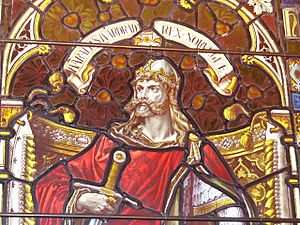
Window with portrait of Harald in Lerwick Town Hall, Shetland
|
See also
 In Spanish: Harald III de Noruega para niños
In Spanish: Harald III de Noruega para niños


